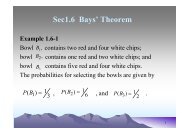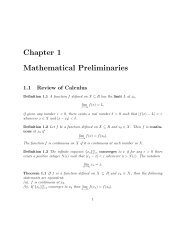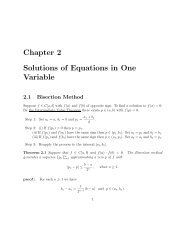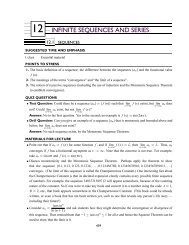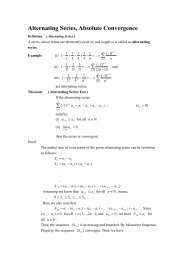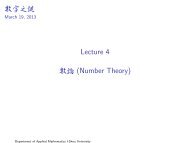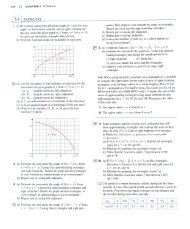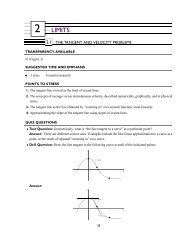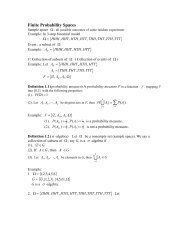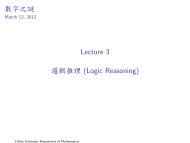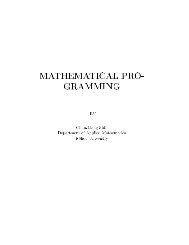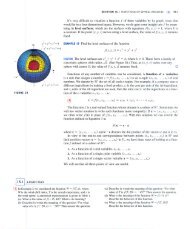16 MULTIPLE INTEGRALS
16 MULTIPLE INTEGRALS
16 MULTIPLE INTEGRALS
You also want an ePaper? Increase the reach of your titles
YUMPU automatically turns print PDFs into web optimized ePapers that Google loves.
<strong>16</strong>.2 ITERATED <strong>INTEGRALS</strong><br />
SUGGESTED TIME AND EMPHASIS<br />
1<br />
2<br />
–1 class Essential material<br />
POINTS TO STRESS<br />
1. The meaning of ∫ b<br />
a<br />
∫ d<br />
c<br />
f (x, y) dydx for a positive function f (x, y) over a rectangle [a, b] × [c, d].<br />
2. The statement of Fubini’s Theorem and how it makes computations easier.<br />
3. The geometric meaning of Fubini’s Theorem: slicing the area in two different ways.<br />
QUIZ QUESTIONS<br />
• Text Question: Consider Figures 1 and 2 in the text. Why is ∫ b<br />
a A (x) dx = ∫ d<br />
c<br />
A (y) dy?<br />
z<br />
z<br />
C<br />
b<br />
x<br />
a<br />
x<br />
0<br />
A(x)<br />
y<br />
x<br />
0<br />
c<br />
y<br />
d<br />
y<br />
Answer: The two integrals express the volume of the same solid.<br />
∫ 4<br />
3 x2 ydydx.<br />
• Drill Question: Compute ∫ 3<br />
0<br />
Answer: 63<br />
2<br />
MATERIALS FOR LECTURE<br />
• Revisit the example ∫∫ (<br />
[−2,2] × [−2,2] x 3 + y 5) dAusing integrated integrals, to illustrate the power of the<br />
technique of iteration.<br />
• Use an alternate approach to give an intuitive idea of why Fubini’s Theorem is true. Using equal intervals<br />
of length x and y in each direction and choosing the lower left corner in each rectangle, we can write<br />
the double sum in Definition <strong>16</strong>.1.5 as the iterated sum<br />
( )<br />
m∑ n∑ ( )<br />
f xij ∗ , ∑<br />
y∗ ij x y = m n∑ ( )<br />
f xij ∗ , y∗ ij x y<br />
i=1 j=1<br />
i=1 j=1<br />
which in the limit gives an iterated integral. Go through some examples such as ∫∫ [−1,3] × [−1,3]<br />
xydA and<br />
∫∫<br />
[0,1] × [0,1]<br />
(2 − x − y) dAto demonstrate this approach.<br />
• Remind the students how, in single-variable calculus, volumes were found by adding up cross-sectional<br />
areas. Take the half-cylinder f (x, y) = √ 1 − y 2 ,0≤ x ≤ 2, and find its volume, first by the “old”<br />
method, then by expressing it as a double integral. Show how the two techniques are, in essence, the same.<br />
881



